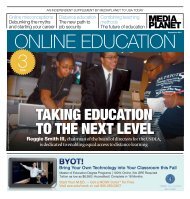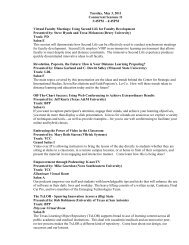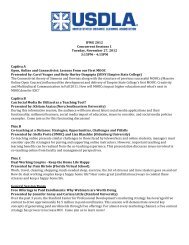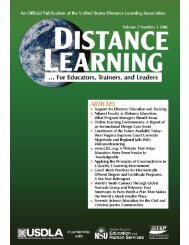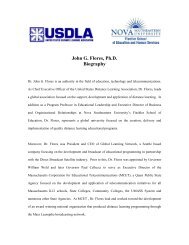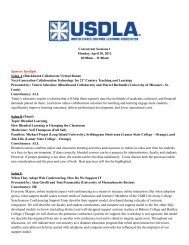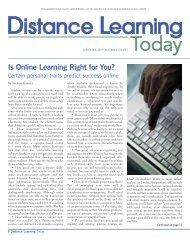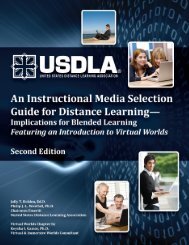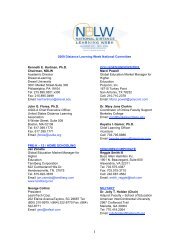United States Distance Learning Association
United States Distance Learning Association
United States Distance Learning Association
- No tags were found...
Create successful ePaper yourself
Turn your PDF publications into a flip-book with our unique Google optimized e-Paper software.
<strong>Learning</strong> Objects<br />
What Are They, and Why Should We Use<br />
Them in <strong>Distance</strong> Education<br />
Robert Keown<br />
Imagine yourself as a student sitting in<br />
a classroom. The instructor is walking<br />
around the room reading from a textbook<br />
and interjecting occasional lecture<br />
items. On occasion the instructor stops to<br />
ask a question or two just to make sure<br />
everyone is listening. Once the questions<br />
are answered and the instructor is satisfied,<br />
the reading and lecturing continues.<br />
You are counting the holes in the ceiling<br />
and fighting to keep your eyelids open as<br />
you watch the clock tick round and round<br />
at a snail’s pace.<br />
Robert Keown, Director of Online <strong>Learning</strong>,<br />
East Central Technical College, 667 Perry<br />
House Rd., Fitzgerald, GA 31750.<br />
Telephone: (229) 468-2022.<br />
E-mail: rkeown@eastcentraltech.edu<br />
Unfortunately, this type of scenario happens<br />
across the educational world every<br />
day. Now imagine the same classroom, but<br />
instead of reading from a textbook and lecturing,<br />
the instructor introduces some<br />
short video and audio clips dealing with<br />
the content. Instead of asking questions<br />
the instructor has you log in to a Webbased<br />
extension of the course and allows<br />
you to select 5 of 10 questions posted and<br />
requests that you develop responses to<br />
them for class discussion. The instructor<br />
then lectures for several minutes and starts<br />
a question-and-answer session discussing<br />
all of the questions that were posed in the<br />
online course extension. Lastly, the instructor<br />
challenges you and the entire class to<br />
log in to the Internet and find material<br />
dealing with the subject matter and gives a<br />
set time to be prepared to present and discuss<br />
to the whole class what you find.<br />
Unfortunately, again, this scenario does<br />
not happen very often; however, technology<br />
and student interaction are becoming<br />
more and more integrated into the traditional<br />
classroom setting everyday.<br />
In the first scenario described, the material<br />
was being delivered in a very boring<br />
manner. Students were not being challenged,<br />
and no involvement was occurring.<br />
Basically, the instructor was trying to<br />
hand-feed the students and allowing them<br />
to just sit and listen with little or no expectations<br />
of demonstrating what they were<br />
learning. This type of classroom setting<br />
gears itself more to the convenience of the<br />
instructor as opposed to being student<br />
Volume 4, Issue 4 <strong>Distance</strong> <strong>Learning</strong> 73



